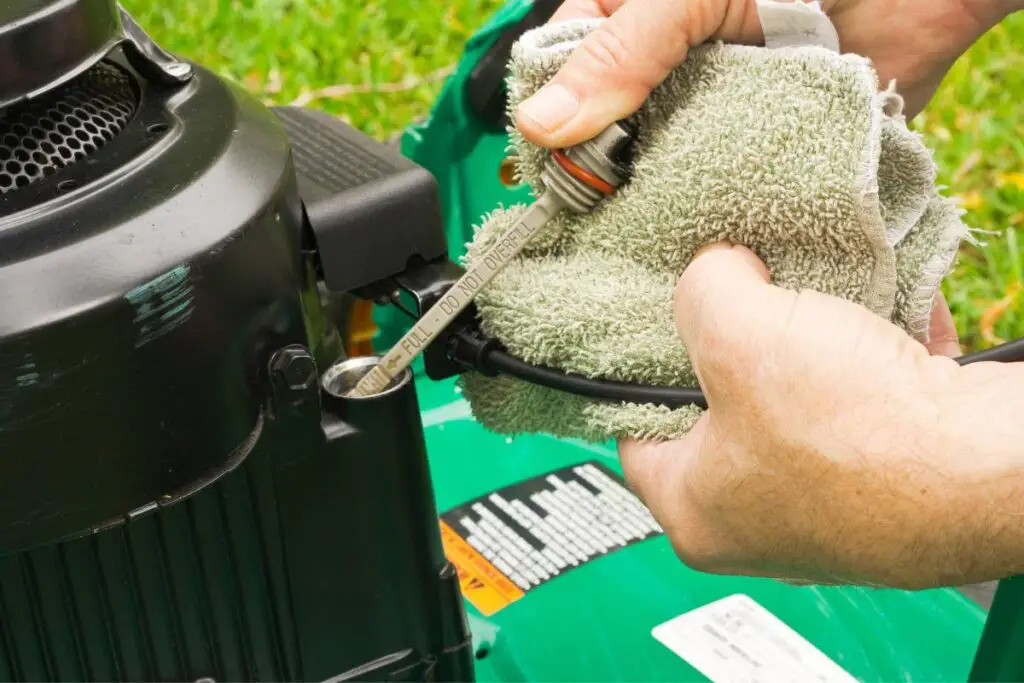You need to add enough fuel and oil for a functional lawn mower. The correct oil quantity is crucial, as too much or too little can affect the lawnmower’s performance and void the manufacturer’s warranty.
In general, The walk-behind lawnmowers take 15-18 oz, while a Self-Propelled Mower takes 20-25 oz. The oil in these mowers should be changed every 50 hours. Also, riding mowers can take around 48-64 oz if single-cylinder and 64-80 oz if twin-cylinder, which needs to be changed every 100 hours.
This question has different answers because the oil quantity depends on various factors. Please stick to the article till the end as we further dive into these factors affecting the oil amount, the importance of using the right amount, and how to check the engine and add oil.

Introduction to Lawn Mowers
Lawn mowers help keep the garden clean, tidy, and attractive. Additionally, clean cuts with good lawn mowers prevent pests and diseases.
Various types of lawn mowers are available, and some commonly used mowers are:
- Rotary mowers
- Reel lawn mowers
- Mowers with batteries
- Riding lawn mowers
- Walk-behind mowers
Lawn mower engines come in two common types:
- 2-cycle mowers, where you mix the oil and fuel in a specific ratio.
- 4-cycle mowers, where the engine uses the fuel to burn and keeps the oil separate.
Like any other combustion engine, the lawnmower’s engine will also need oil to run.
Some simple engines have moving parts designed to function at high speeds and temperatures.
So, lubricating and cooling with oil is essential.
Without the oil, the lawnmower’s engine will overheat and stop functioning.
3 types of oil for Lawn Mowers
Various types of oil are available for lawn mowers.
The oil type recommendations, however, will vary based on the make and model of your mower.
If your mower brand is Cub Cadet, Toro, etc., it may have an engine model similar to the Honda, Briggs and Stratton, and Kohler.
The oil type for the lawnmower depends on the outside temperature because it can change the oil’s viscosity.
The best type of oil for modern engines is 10W30, and the older engines use SAE30.
Here are some ideal oil types for lawn mowers are as follows:
1. Single grade oil
Oils like SAE30 are single-weight or single-grade oil, have a good working range, and are ideal for older engines.
The oil has a suitable working temperature ranging between 400 and 100°F.
2. Multi-grade oil
A multi-grade oil is excellent for modern engines.
The oil is designed to protect modern engines that work in high or fluctuating temperatures.
I use multi-grade oil for my lawn mower.
I have also used single-grade oil, but I have witnessed the multi-grade mower protecting my mower efficiently against temperature swings.
Additionally, the multi-grade oils have two viscosity ranges that protect a mower, especially a 4-stroke engine mower, and encourage them to work smoothly.
The older engines use a 10W-30 multi-grade oil, and the modern engines use SAE 30.
3. Synthetic oil
Partial and complete synthetic oils can protect your lawn mower engines. But they are expensive.
Synthetic oils can lubricate the engine. The detergent components in the oil will clean and break down the contaminants by combustion, improving the engine’s performance.
If not cleaned, these contaminants can change into a black sludge, feed on the metal, and clog the oil passages.
While selecting synthetic oils, look for labels like API (American Petroleum Institute) seal or ACEA (Association des Constructeurs Européens d’Automobiles) seal.
Importance of maintaining the proper oil level
It is essential to have the right amount and level of oil in the lawn mower.
Engine oil can serve multiple purposes, cooling and lubricating the engine being the common one.
Enough oil will help the engine work efficiently, prevent overheating, lubricate the engine parts, and increase the mower’s lifespan.
Looking for gardening supplies? We have tested 100's of products before recommending them to you guys. Check out our best pick below:
| Image | Gardening Supplies | Best Price? |
|---|---|---|
 Top
Top Top
Top | Raised Garden Bed Kit | Check On Amazon |
 | XLUX Soil Moisture Meter, Plant Water Monitor, Soil Hygrometer Sensor for Gardening, Farming, Indoor and Outdoor Plants, No Batteries Required | No Results |
 Top
Top Top
Top | 82 Pcs Garden Tools Set and Extra Succulent Tools Set | Check On Amazon |
 | Joeys Garden Expandable Garden Hose with 8 Function Hose Nozzle, Lightweight Anti-Kink Flexible Garden Hoses, Extra Strength Fabric with Double Latex Core, (50 FT, Black) | No Results |
 Top
Top Top
Top | Dual Chamber Compost Tumbler | Check On Amazon |
 Top
Top Top
Top | Sunnyglade Plant Stakes | Check On Amazon |
 Top
Top Top
Top | Organic Cold Pressed Neem Seed Oil | Check On Amazon |
 Top
Top Top
Top | Mighty Mint Gallon :-Insect and Pest Control Peppermint Oil | Check On Amazon |
 Top
Top Top
Top | Scotts DiseaseEx Lawn Fungicide | Check On Amazon |
 Top
Top Top
Top | Jacks Classic 20-20-20 All Purpose Fertilizer | Check On Amazon |
 Top
Top Top
Top | 30,000 Seeds Pollinator Attracting Wildflower Mixture | Check On Amazon |
 Top
Top Top
Top | Survival Vegetable Seeds Garden Kit-Over 16,000 Seeds | Check On Amazon |
How much oil does a lawn mower take?

Generally, the manufacturer recommends how much engine oil the lawn mowers need.
You can, however, also search the engine’s oil capacity online and use it according to the make and model of your mower.
Most lawn mower engines need only 20 to 24 fluid ounces of oil.
The small engines generally use the SAE-30 single-grade detergent motor oil with service-rated SG or higher.
The other types of mowers can use multi-viscosity oils like the 10W-30 or 10W-40 oils.
Several factors determine the amount of oil needed by lawn mowers.
Below are some common factors you should consider while filling the crankcase with oil.
Engine size and age
The amount of oil a lawn mower can take depends on the engine size.
For example, if your lawnmower has a small engine, use around 16 to 24 fluid ounces of oil for the small engine.
For large engines, use 48 to 64 fluid ounces of oil.
Size and age will go side by side here.
Be it the small or the large engines, the amount of oil you add will be 4 to 8 fluid ounces more than the general amount.
For example, if the average oil amount of a small engine is 16 to 24 fluid ounces, you need to add 20 to 32 fluid ounces if the engine is quite old.
Type of oil
The type of oil can affect the amount of oil the lawn mower uses.
It is because different oils have different viscosities, i.e., the oil thickness or fluidity.
The mower will need thicker oils in more amounts than the thinner oils to receive enough lubrication.
Conventional oils have high viscosity, which means they are thicker in consistency. So, you need conventional oils in more amounts.
Though thinner oils are used in fewer amounts, you must replace them frequently as they can break down and evaporate faster than thicker oils.
Synthetic oils have low viscosity, which makes them flow faster than conventional oil.
So, synthetic oils will be needed in fewer amounts, but you must change them frequently.
Lawn mower types, brands, and their oil capacity
The oil capacities of different lawn mowers are different. So, how much oil a lawn mower can take will vary for different lawn mowers.
- Oil capacity for most of the walk-behind lawn mowers is around 15 oz to 18 oz.
- Some walk-behind mowers need 20 oz to 24 oz. of oil. Change the oil every 50 hours or annually.
- The oil capacity of the riding lawn mowers is around 48 oz. to 64 oz. Change the oil every 100 hours after use or annually, whichever comes first.
- The oil capacity of the push mowers is around 18 to 20 ounces or, sometimes, 20 to 40 oz. (0.5 to 1 quart), based on the engine size.
- Self-propelled mowers’ oil capacity is 20 to 40 ounces.
| Lawn Mower Type | Oil Requirement |
|---|---|
| Push Mower (4-cycle engine) | 15-18 oz |
| Self-Propelled Mower (4-cycle engine) | 20-24 oz |
| Riding Mower (single-cylinder 4-cycle engine) | 48-64 oz |
| Riding Mower (twin-cylinder 4-cycle engine) | 64-80 oz |
| Zero Turn Mower (twin-cylinder 4-cycle engine) | 64-80 oz |
Below are some popular lawn mower brands and their oil requirements:
- Honda: 18 oz of oil
- Briggs and Stratton: 48 oz to 64 oz of oil
- Toro: 16 oz of oil
- John Deere: 48 oz of oil
- Craftsman: 20 oz of oil
- Husqvarna: 48 oz of oil
Manufacturer recommendation
The manufacturer’s recommendation is fundamental when choosing the lawn mower oil amount.
It may or may not match the average amount of oil I have shared.
The oil type, amount, and viscosity described in the manufacturer’s manual will determine the oil’s flow and how it provides adequate lubrication to the engine’s parts.
So, check the manual before you choose any average amount from online research.
Maintenance regularity
Maintenance can also affect the amount of oil the lawn mower needs to some extent.
Regularly maintaining your mower will use only the required amount of oil to run correctly.
But if the mower is poorly maintained, it will consume more oil for the best performance.
As a result, you have to use more oil than the mower’s capacity.
For adequate maintenance, change the oil regularly, keep the oil levels in check, avoid overfilling or underfilling the engine, and clean or replace the air filters and spark plugs.
Risks of adding too much oil
Less amount of oil will lead to poor functioning of the lawn mower.
But adding too much oil does not solve the problem either. Instead, it can give rise to numerous problems accompanied by frequent white smoke.
When the engine contains excessive oil for lubrication and cooling, it will increase the friction between the engine parts.
As a result, the wear and tear in the engine parts will increase and reduce the mower’s performance and shelf life.
What to do if you add too much oil?
When you see white smoke from your engine, you have added excessive oil, and now the engine is burning this oil.
If you have added excessive oil, you can remove the excess oil with the help of an oil pump.
Tilt your lawn mower carefully, and slowly move the oil into the drain pan.
If you don’t want to tilt, use a suction pump to remove the excess oil.
To prevent this from occurring further, add the soil slowly and check the dipstick until the oil reaches the correct level.
The dipstick style may vary based on the lawn mower type, but its purpose is the same.
They have upper and lower marks, recognized as holes, lines, or hatched areas.
You have enough oil when the oil level comes between these two marks.
But to fill the engine adequately, you can reach slightly close to the upper mark.
Avoid crossing the upper mark, or you will again overfill your engine.
When to check and change the oil?

Keeping the right level of oil is essential for the mower’s functionality.
To ensure your engine is running correctly, keep checking the oil level.
If you do not know how regularly you have to check, check it every time you refuel the engine.
Once you build up the habit of checking the oil level during refueling, you will never overfill the engine.
Along with checking, changing the oil is also essential.
The oil can become contaminated over time, losing its capability to cool and lubricate.
Keeping old oil will reduce the engine’s efficiency. So, you need to add fresh oil.
For the walk-behind mowers, change the oil every 50 hours or annually, and for riding lawn mowers, change the oil every 100 hours or annually.
How to change the oil in the lawn mower?
Here are some steps that I follow to change the oil in lawn mowers:
Step 1
Place your lawn mower flat over the ground and let the oil settle down.
Also, make sure that the mower will cool to touch.
A flat surface will let you know the exact oil level and whether you need to add more or remove excess oil.
Step 2
Before you add oil, you need to check and confirm whether your lawn mower needs oil to add or not.
Search for the dipstick inside the mower. The dipstick will be present at the side of the mower engine.
You can skip this step if you add oil to the new or empty engine for the next mowing session.
Step 3
Remove the cap and clean the spot to prevent dirt and debris from falling into the oil.
Now, remove and clean the dipstick with a clean rag.
Ensure that the dipstick’s tooth cap matches the dipstick tube’s groove.
Wait for some time and remove the stick again. Check it to see the oil level in it.
There will be two levels – low level (L) and high level (H).
You have a low oil level when the oil level is below the L marking.
You have the correct oil level when the oil level is between the L and H marking.
Excessive oil must be drained to prevent damage and smoke if the oil level exceeds the H marking.
Step 4
Now, add oil if the oil level is below the L marking.
Make sure to keep the level between the H and L markings.
You can go slightly near the H marking for the best but stay within it.
Overfilled engines will increase friction between the engine parts, cause faster wear and tear, and lead to frequent stalling. Besides, this excess oil will burn and lead to white smoke.
Step 5
After adding oil, wait some time to let the oil settle down ultimately.
Again check the level with the dipstick. If the level is still below the L marking, add more oil.
Stop adding oil if the level has reached between the L and H marking or is slightly below the H marking.
Test your mower engine.
Tip: Before you drain the oil or add extra oil, wait some time to let the oil settle to its highest whole level. It will let you know whether you need to add extra oil or remove the excess oil.
Ideal oil recommendations for lawnmowers
- Vanguard 15W-50
- SAE 5W-30
- Synthetic SAE 5W-30
- SAE 10W-30
Safety considerations and mower maintenance
To keep the lawn mower safe and increase its lifespan, follow the following safety and maintenance tips:
- Avoid overfilling your lawn mower. Beginners can make this mistake, thinking more oil will increase the mower’s performance. But, ultimately, you are reducing the engine’s efficiency to work well. The oil level has to be correct.
- Some mower owners underfill the engine due to the fear of overfilling it. To avoid this, utilize the dipstick to add the right amount of oil. Less amount of oil means less lubrication and overheating.
- When changing the oil, use the type recommended for your lawn mowers. Please consult the manufacturer’s manual or ask the experts to give you the correct oil and use it as long as you have the mower.
- Keep checking the oil level every time you add new oil.
- Before you add oil, bring your mower over a flat surface and let it settle down to receive information about the exact oil level.
- Maintain your lawn mower by cleaning/replacing the fuel filters, air filters, fuel lines, and spark plugs. Clean the carburetor regularly with carb clean and clean and sharpen the blades regularly to get clean grass cutting.
Final thoughts
Maintaining the proper oil level in the lawn mower is essential for the mower’s engine. It will keep the engine safe, encourage it to run smoothly and efficiently and increase its lifespan. Most mowers will generally take around 20 to 25 oz. of oil.
But it can vary based on various factors, like the lawn mower type, engine type, size, age, oil capacity, make and model, etc. It is essential to consider every factor before adding oil to the mower.
Additionally, check the oil’s level with a dipstick to determine whether you need to add or remove the excess. Follow the safety and maintenance tips to improve your mower’s performance and lifespan.
Which oil is considered best for most lawnmowers?
The best type of oil for most lawnmowers is SAE 30. If you are from colder regions, SAE 5W-30 is the best option. When the temperature in your area fluctuates between 0°F and 100°F, stick to SAE 10W-30 motor oil.
Can I use car oil for a lawn mower?
If you want to use car engine oil for your lawn mower, use 5W-30 or 10W-30.
Reference: Lawnmower Wikipedia.
